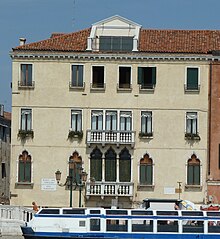Palazzo Molina
Palazzo Molina , also Palazzo delle Due Torri or Palazzo Navager , is a Gothic palace in Venice in the Italian region of Veneto . It is located in the Sestiere Castello on the Riva degli Schiavoni with a view of the Bacino San Marco next to the Ponte del Sepolcro , which was formerly called Ponte di Ca 'Navager . The palace belonged to the poet Francesco Petrarca for about five years .
history
The palace originally belonged to the Navager or Navagero family ; their family coat of arms can be seen on the fountain in the courtyard, as well as on some properties and houses that the family bought in 1483 from the monks of San Michele in Isola and Sant'Andrea d'Ammiana . In the palace lived the historian Andrea Navagero and his nephew of the same name (1483-1529), a statesman, poet, historian and botanist in Venice who died in Chantemerle-les-Blés as ambassador to France .
The palace remained in the family until the last offspring, Pieto Navagero , died in 1743. In the area there was once a monastery of the Holy Sepulcher (it .: Sepolcro) and a building with two towers (it .: Due Torri).
House of Petrarch
The palace is also known locally as the "House of Petrarch". Petrarcha's daughter Francesca and her husband Francescuolo da Brossano lived there with their family together with the famous poet from 1362 to 1367.
The idea of living in Venice came to Petrarch through his great admiration for the Serenissima, which considered the “miracle of citizenship”. Petrarch, on the other hand, could rely on many friends in Venice, especially among the chancellors. A very special friend of diplomatic rank was the Gran Cancelliere Benintendi de Ravegnani , who helped secure the donation from Petrarch's library to the Biblioteca Nazionale Marciana , even if many of these texts were lost.
description
The four-story house in Gothic style has three rectangular portals in the middle on the first floor overlooking the Riva degli Schiavoni , flanked by two pairs of rectangular windows. On the first main floor, the middle triple three-pass arched window with a protruding, balustrated balcony is the eye-catcher. There is a pair of individual three-pass windows on both sides. The window layout on the second main floor corresponds to that of the first main floor, but the windows are smaller and rectangular. The third main floor has only two simple rectangular windows in the middle, flanked by two pairs of similar windows. A large dormer window with a tympanum and a three-winged rectangular window sits in the middle above the serrated eaves .
The facade is plastered and painted light yellow. The window frames and the parapets of the balconies are made of Istrian limestone .
Individual evidence
- ↑ Giuseppe Tassini: Alcuni palazzi: ed antichi edificii di Venezia . Filippi, Tipografia M. Fontana. Pp. 129-132. 1879. Retrieved January 28, 2020.
- ^ Henry Calthorp Hollway: Petrarch: His Life and Time . P. 241. Retrieved January 28, 2020.
- ↑ Riva degli Schiavoni, no.4145 . Archived from the original on September 27, 2007. Retrieved January 28, 2020.
- ↑ Miracle of Civitas . Archived from the original on September 27, 2007. Retrieved January 29, 2020.
Web links
Coordinates: 45 ° 26 '2.5 " N , 12 ° 20' 44.2" E.

